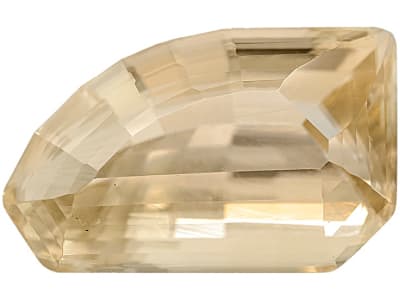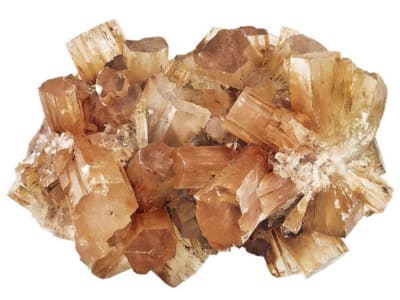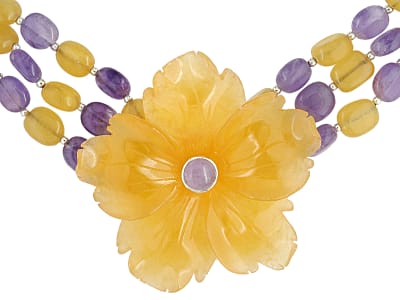Aragonite's name is derived from the location of Molina de Aragon, Spain, the province where it was first discovered. Aragonite occurs in Agrigento, Sicily, Italy, in the famous sulfur mines, as well as on Mount Vesuvius, Italy. Aragonite specimens are highly prized by mineral collectors for their wide variety of forms, which include twins and pseudomorphs (uncharacteristic crystal forms). As a bonus, many specimens are fluorescent as well as phosphorescent, a rare occurrence among minerals. In the Sisk Gemology Reference, Jerry Sisk writes, "Aragonite is a fascinating mineral." In its biogenic form, it is produced by marine mollusks and one of two components within the nacre of pearls. It's also found in coral. (The term biogenic is used for any gem material derived from living organisms.) Aragonite is a polymorph of calcite, sharing the same chemical formula but with different crystal structures. We like aragonite as a gemstone for collectors, although it is occasionally set in jewelry.
General Information
LWUV: Variable
Aragonite Colors
-
 Blue
Blue -
 Brown
Brown -
 Colorless
Colorless -
 Gray
Gray -
 Green
Green -
 Pink
Pink -
 Purple
Purple -
 Red
Red -
 White
White -
 Yellow
Yellow -
 Yellow
Yellow -
 Yellow
Yellow
Countries of Origin
Papua New Guinea; Kazakhstan; Portugal; Bahamas; Greece; Mongolia; Morocco; Unknown; Iraq; Chile; Argentina; Ukraine; India; Canada; Turkey; Belgium; Namibia; Finland; South Africa; Peru; Turkmenistan; Venezuela (Bolivarian Republic of); Germany; Tanzania, United Republic Of; Viet Nam; Thailand; United Kingdom of Great Britain and Northern Ireland; Kiribati; Sweden; Poland; Bulgaria; Jordan; Kuwait; Nigeria; Tunisia; Palestine, State of; Croatia; Tuvalu; Kenya; Switzerland; French Polynesia; Spain; Azerbaijan; Cuba; Mauritania; Congo (the Democratic Republic of the); Israel; Australia; Tajikistan; Myanmar; Cyprus; Iceland; Oman; Austria; Mozambique; Luxembourg; Brazil; Algeria; Cabo Verde; Slovenia; Colombia; Ecuador; Hungary; Republic of Kosovo; Japan; Taiwan (Province of China); Albania; Bolivia (Plurinational State of); Lao People's Democratic Republic; New Zealand; Vanuatu; United States Minor Outlying Islands; Honduras; Italy; Antarctica; Macedonia (the former Yugoslav Republic of); Afghanistan; Russian Federation; Czechia; United States of America; Egypt; Saudi Arabia; Netherlands; Pakistan; China; Ireland; Qatar; Slovakia; France; Serbia; Kyrgyzstan; Romania; Uzbekistan; Norway; Mexico; Zimbabwe; Indonesia
Care
Aragonite is very soft, so be mindful of scratching. It is easily attacked and dissolved by acids such as vinegar. Avoid abrasives, ultrasonic, solvents and heat. Aragonite is generally unsuitable for jewelry.
More About Aragonite
Aragonite is one of the few stones that is both biogenic and inorganic. Collectors are drawn to Aragonite because of its unusual crystal structure.



